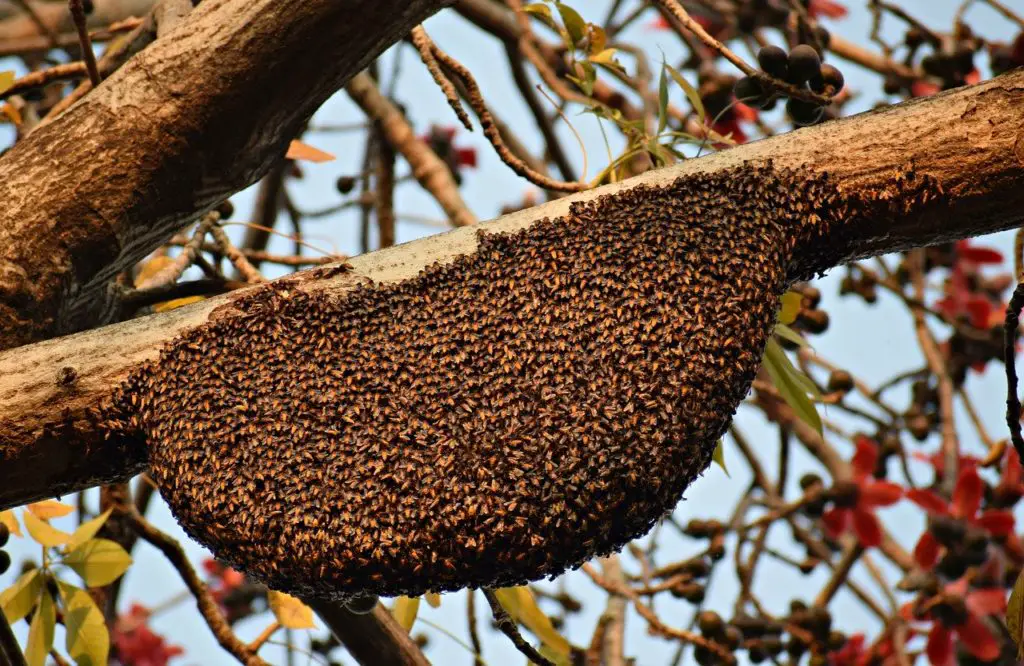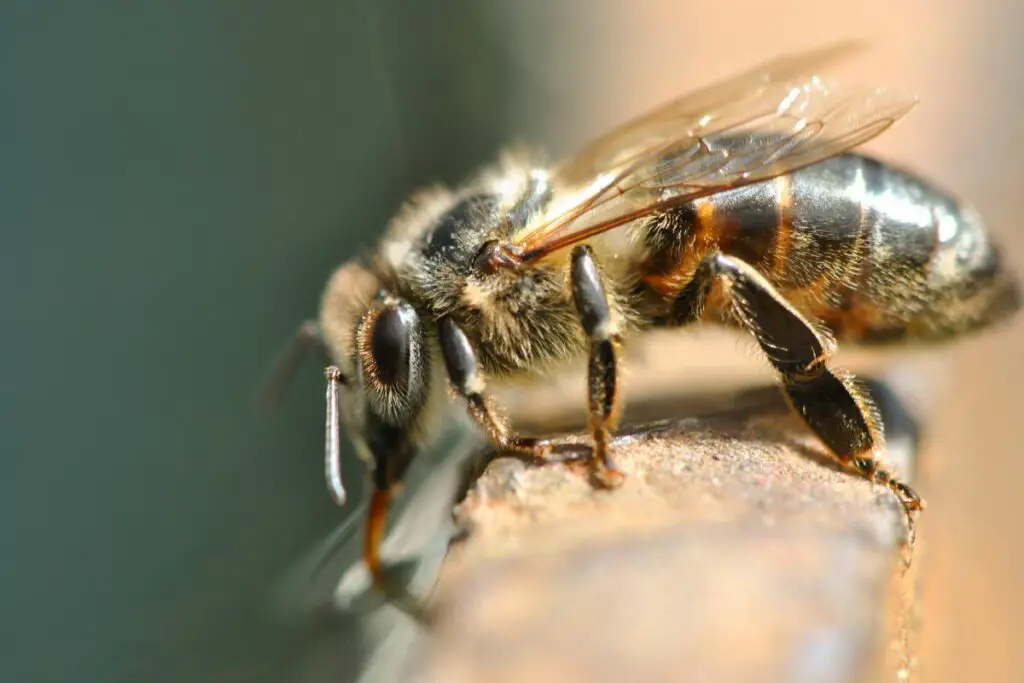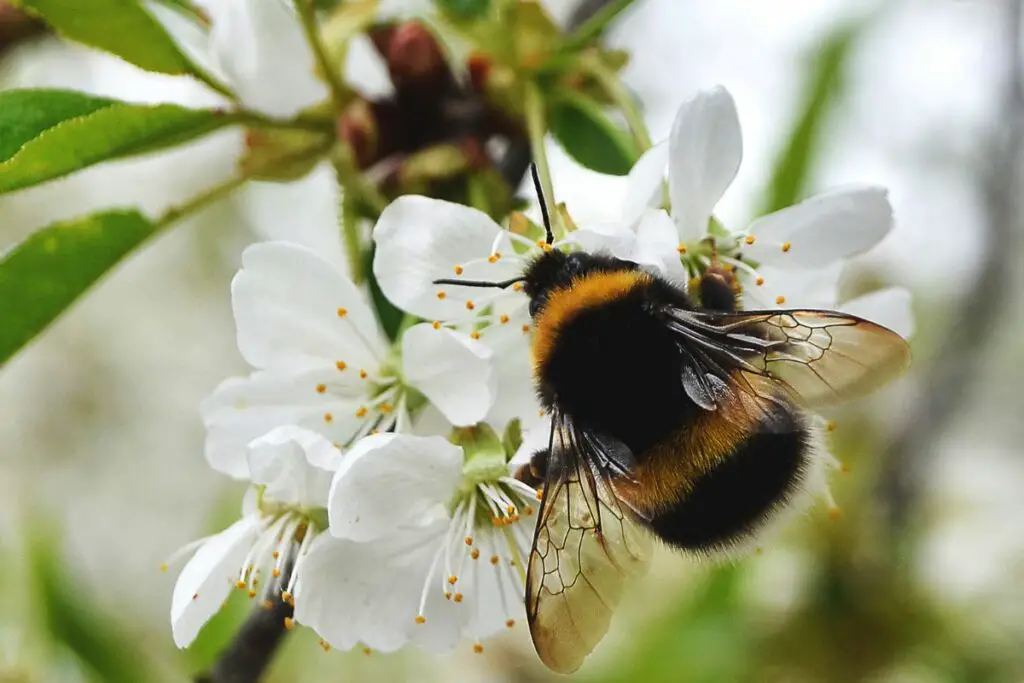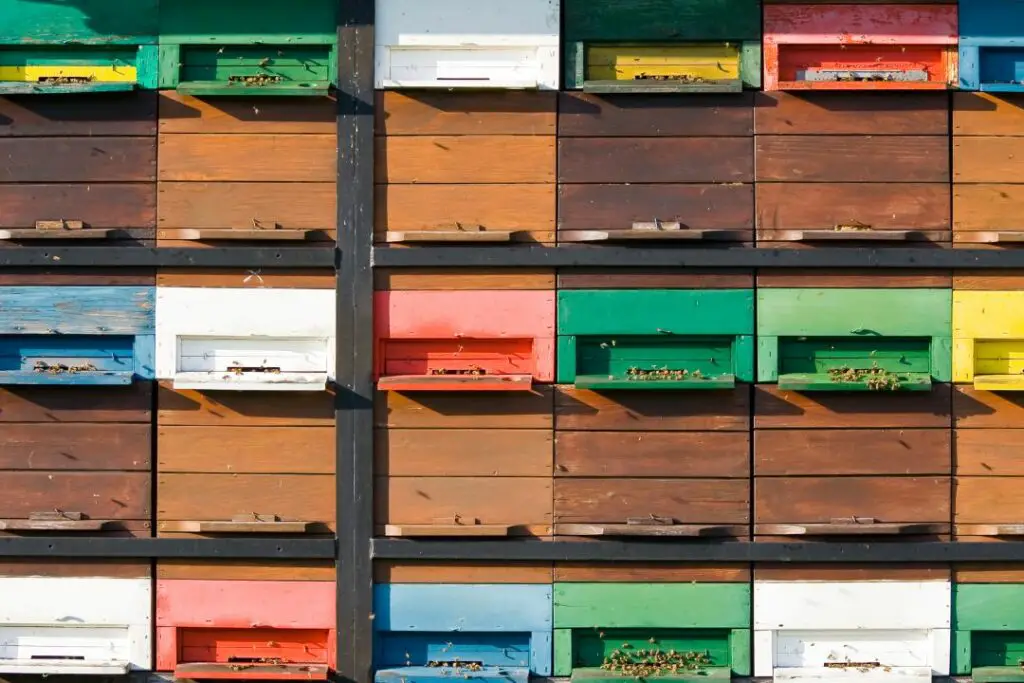Last updated on December 11th, 2023 at 02:32 pm
A honey bee hive population will begin to swarm when it reaches breaking point. The reigning queen and anywhere from a third to a half of the current colony will leave to find a suitable location to build a new nest.
The remaining residents will start producing a new queen that will quickly take her place as the new matriarch.
But what creates this fascinating migration at such a large scale?
Let’s dive deep into why bees swarm, including everything you need to know about honey bee swarms, one of nature’s most fascinating reproductive processes.
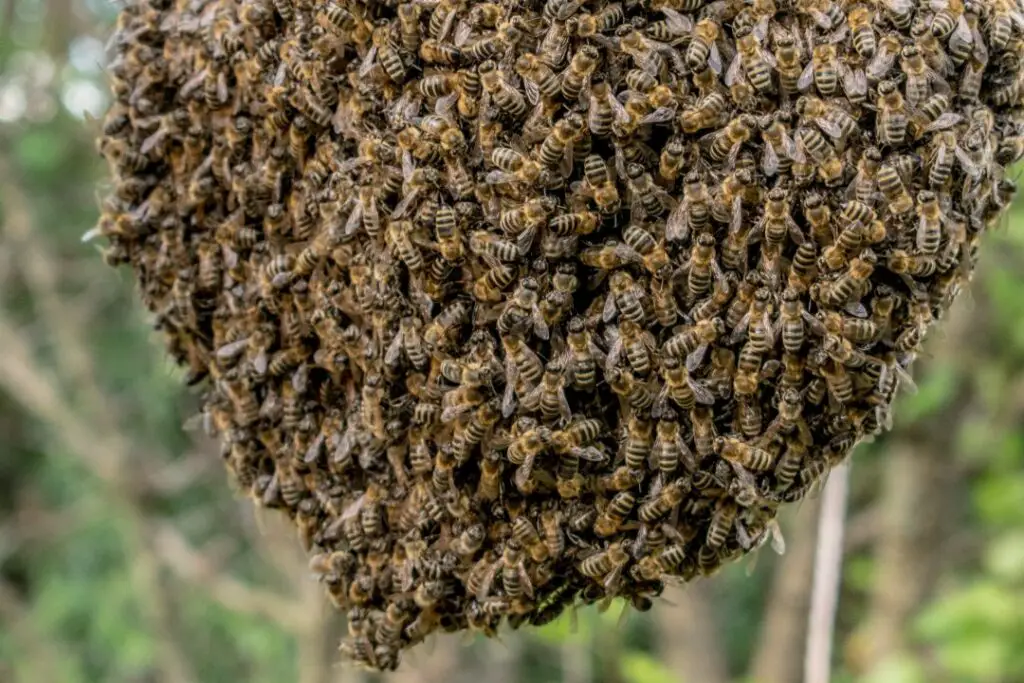
Do all kinds of bees swarm?
No, it’s only the honey bee (apis mellifera) that swarms to find a new home.
Bumblebees, carpenter and mining bees live in much smaller concentrations and don’t need to swarm to find a new place to live or raise their young.
What makes bees swarm?
Mostly, it’s all about numbers, but there are other more sinister reasons a colony of honey bees might up and leave.
Overpopulation
An ample old tree hollow can quickly get too small for a growing colony of bees. When conditions start to get cramped, the bees inside initiate swarming.
This is common with managed bees in hives as the frames become packed with honey and larvae, leaving no room for the worker bees.
If left unchecked, this could pose severe risks to the whole bee population, with a higher likelihood of infection and disease due to the packed conditions.
Other factors
Sometimes, colonies will fall prey to disease, parasites or a lack of food and water, which can cause bees to up and swarm.
Pesticides in the local area can also cause swarms to escape the pesticide’s poisonous effects.
The worker bees and the queen will make no preparations for a successor or the continued existence of the current hive.
All the bees capable of taking flight will abscond in one large swarm, hoping to find somewhere far enough away from the toxic effects of the pesticide.
Reproduction
Honey bees vary considerably in their temperaments and their swarming habits.
However, all honeybee colonies act on a level higher than the individual bee. This ‘hive mind’ will be motivated to reproduce and continue the species’ survival.
One of their strategies to increase the species’ populations is to send out an expeditionary force of scout bees to try and start a new colony elsewhere.
This means that some of the hive’s occupants will begin to swarm despite ample space in the nest.
This will allow two queens in separate hives to continue producing a brood, effectively doubling the reproduction rate.
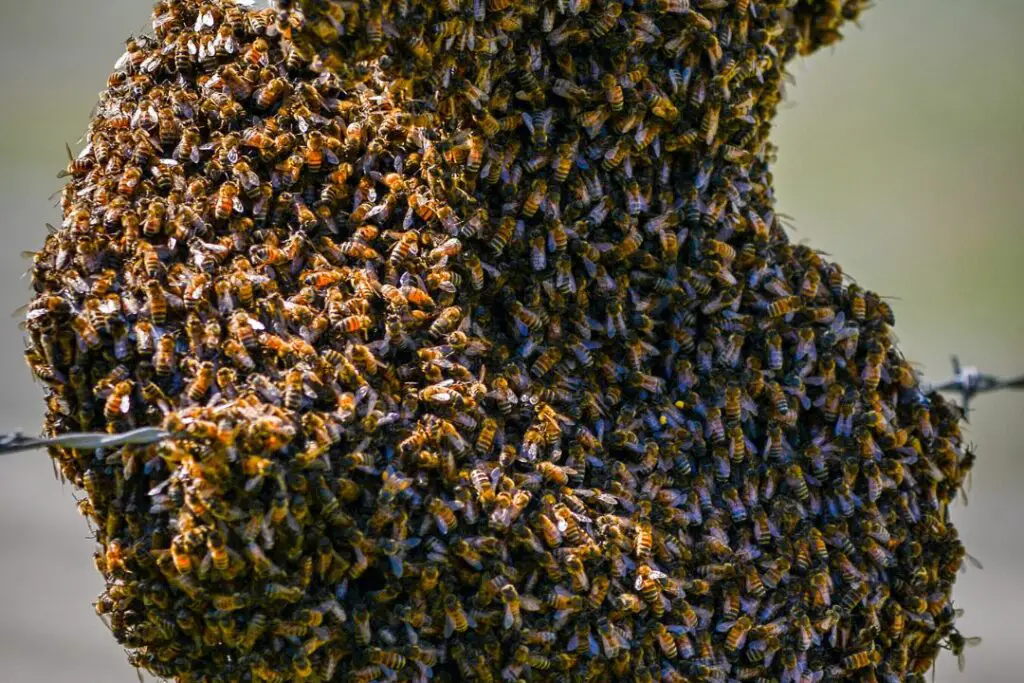
How does it happen?
Swarming requires careful prior planning and perfectly timed execution to transplant half a population.
Usually occurring in spring during warm weather, the bees begin by putting the queen on a diet.
Due to their size, queen bees are not the best flyers and require rest. Any excess weight shed before the flight will make the swarm’s journey safer and shorter.
Unlike the much heavier queen bee, the bees departing with her will gorge on honey. This helps them store energy for the flight ahead and produce more wax.
Using glands in their abdomen, they produce wax that oozes from their pores and forms flakes.
When they find their new home, they chew on the flakes to create a putty that can make a honeycomb and kick-start the new nest.
*Interesting fact – Most queens must fly over 250m to find a new location for the hive.
Workers build new queen cups (cells) in the hive to harbour royal larvae ready to supersede the old queen after she leaves.
The current queen will start to lay eggs in the queen cups. These larvae are fed a diet of exclusively ‘Royal Jelly’, a nutrient-dense, milky-white secretion from the glands in the heads of worker bees.
When the first queen hatches, she will ensure she is the only surviving successor by killing any developing rivals.
This process is helped by workers who remove the wax capping on other cells to allow her to dispatch her unhatched sisters.
The heart of the swarm
Once all preparation is complete, the queen will leave with somewhere between a third and half of the colony’s total population, taking to the skies for a new home.
*Interesting note – The bees that leave the old nest are called the ‘Prime Swarm’.
At first, the swarm will complete a small flight. Sometimes, this may be a trip to a neighbouring tree branch well within sight of the existing nest.
Finding the new nest
From this position, scout bees are deployed to search for potential new nest sites. The location must be sheltered from the elements but requires sunlight for warmth.
It needs a small protected entrance and no other unwanted inhabitants within.
When these criteria are met or partially met, the scout bee will return to the swarm to report her findings.
These can include:
- Tree hollows
- Man-made cavities in buildings
- Caves
- Bee hives
- Chimneys
After finding what they believe is a suitable new nest site, they return to the swarm to report their findings. They do this using a fascinating process called the waggle dance.
This dance consists of a series of movements that resemble a figure-eight pattern.
The bee starts with a straight run, vigorously shaking its body side to side, then circles back to the starting point, alternating between left and right turns after each straight run.
The vigour and energy portrayed in this majestic dance communicate the new nest site’s potential success, direction and distance.
Other scouts will be persuaded to inspect the location of the dance is’ attractive’ enough.
This time frame for these house-hunting trips is roughly three days and only ends when one potential nest site gets approximately 80% of the scout bees’ approval.
Once this startlingly democratic process has been completed, the whole swarm will take flight, with scout bees flying above the swarm to guide it safely to the new location.
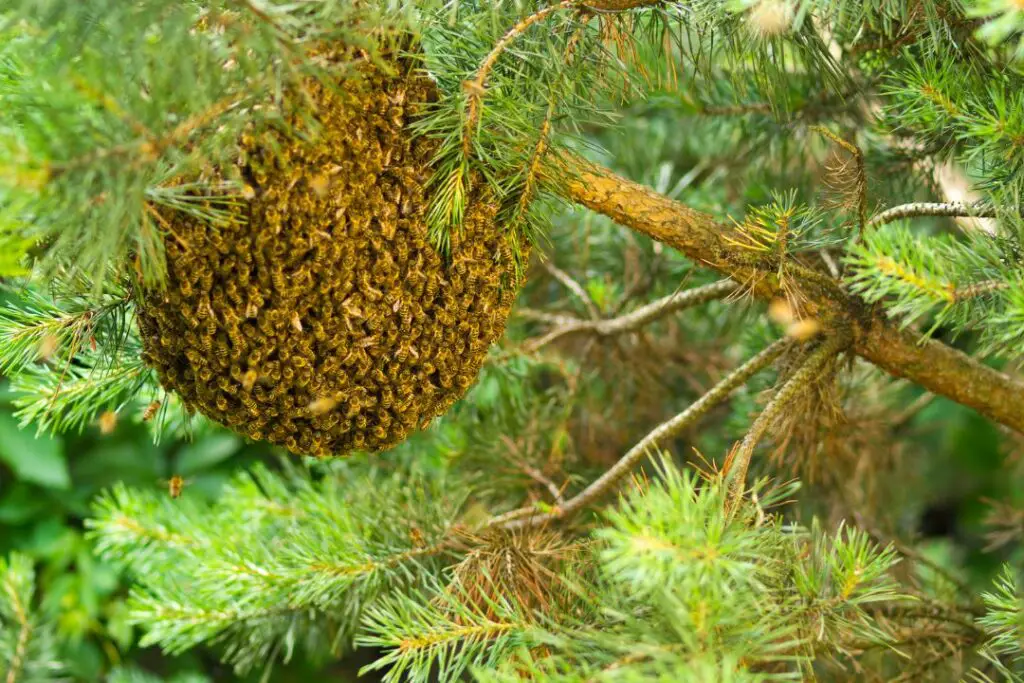
Human interaction
Considering the population of us and the honey bee, human and swarm interaction is still rare but seems to be on the rise in recent years.
This could be due to increased urban beekeeping or the exceptionally high temperatures we’ve been experiencing in late spring and early summer.
On the whole, honeybees are reasonably calm during their swarming period. Despite its somewhat threatening look, a buzzing bee whirl remains pretty docile.
The swarm will only attack in defence if they feel intimidated or if the queen is threatened (like when you see morons dousing them with a hose pipe).
If you come across a swarm in an urban environment where they are a threat to themselves or other people, your best course of action is to contact a local beekeeper in the hope they have a vacant hive.
If you can’t find anything immediately online, you can use the British Bee Keeping Association’s handy little tool to locate a nearby swarm collector.
Conclusion
Swarming is crucial in colony reproduction, ensuring hives are not overpopulated.
Without it, honey bees wouldn’t be the absolute powerhouse pollinator they are today.
If you’ve enjoyed this short read, don’t miss our other fascinating dive into the world of bees waiting below.

